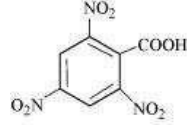An organic compound (A) (molecular formula (C8H16O2) gives a carboxylic acid (B) upon hydrolysis by dilute sulphuric acid and an alcohol (C). Oxidation of(C) with chromic acid produces(B). (C) on dehydration gives but-1-ene. Compound B is:
1.
Butanoic acid
2.
Propanoic acid
3.
Butanol
4.
Propanoic acid
Arrange them in increasing order according to their reactivity towards HCN:
Acetaldehyde, Acetone, Di-tert-butyl ketone and Methyl tert-butyl ketone;
1. Di-tert-butyl ketone > Methyl tert-butyl ketone > Acetone > Acetaldehyde
2. Di-tert-butyl ketone < Methyl tert-butyl ketone < Acetone < Acetaldehyde
3. Di-tert-butyl ketone < Acetone < Methyl tert-butyl ketone < Acetaldehyde
4. Methyl tert-butyl ketone < Di-tert-butyl ketone < Acetone < Acetaldehyde
Phthalic acid on heating with SOCl2 gives:
| 1. | Phthalic anhydride | 2. | Phthalamide |
| 3. | Phthaloyl chloride | 4. | None of the above |
An organic compound (A) contains 69.77% carbon, 11.63% hydrogen, and rest oxygen. The molecular mass of the compound is 86. It does not reduce Tollens’ reagent but forms an addition compound with sodium hydrogen sulphite and gives a positive iodoform test. On vigorous oxidation, it gives ethanoic and propanoic acid. Compound A would be:
1. Pentan-2-one
2. Butanone
3. 3-Methylbutanone
4. Propan-2-ol
Arrange the following compounds in increasing order of their boiling points:
CH3CHO, CH3CH2OH, CH3OCH3, CH3CH2CH3
The correct sequence of increasing orders of reactivity in nucleophilic addition reaction is:
1. Butanone < Propanone < Propanal < Ethanal
2. Butanone > Propanone > Propanal > Ethanal
3. Butanone < Propanal < Propanone < Ethanal
4. Propanal < Propanone < Ethanal < Butanone
Arrange the following compounds in increasing order of their reactivity in nucleophilic addition reactions :Benzaldehyde, p-Tolualdehyde, p-Nitrobenzaldehyde, Acetophenone.
1. Acetophenone < Benzaldehyde < p-tolualdehyde < p-Nitrobenzaldehyde
2. Acetophenone < p-tolualdehyde < Benzaldehyde < p-Nitrobenzaldehyde
3. Acetophenone > p-tolualdehyde > Benzaldehyde < p-Nitrobenzaldehyde
4. Acetophenone < p-tolualdehyde < p-Nitrobenzaldehyde < Benzaldehyde
What will be the IUPAC names of the following compound ?

1. 2,4,6-Trinitrobenzoic acid
2. 1,3,5-Trinitrobenzoic acid
3. 2-oxo-1,3,5-dinitrobenzene
4. None of the above
Cannizzaro’s reaction is not given by:
| 1. |  |
2. |  |
| 3. | HCHO | 4. | CH3CHO |
The compound below is treated with a concentrated aqueous KOH solution. The products obtained are:
| 1. |  |
| 2. |  |
| 3. |  |
| 4. |  |



